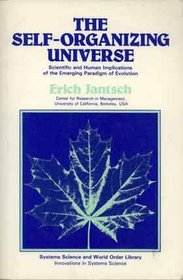Unless otherwise noted,
all text on this page may be used under the terms of a
Creative Commons License.
However, all graphics on this page are copyright their original author or publisher, apart from those indicated to be public domain.
| Cosmic Evolution | ||
| Cosmic Evolution | The Self-Organizing Universe |
| Complexity | Palaeos | Emergence | ||
| Time | Biological Evolution | Abiotic | Cosmos | Science |

Erich Jantsch: (1929-1980) Austrian astrophysicist whose 1979 lectures in System Science at the University of California in Berkeley became the basis for his book The Self-Organizing Universe: Scientific and Human Implications of the Emerging Paradigm of Evolution (Pergamon Press, 1980). This now long out of print work deals with self-organization as a unifying evolutionary paradigm that incorporates cosmology, biology, sociology, psychology, and consciousness. While obviously not the first to present a unified scientific account of the story of creation, it is probably the most ambitious and inspirational, and in my (MAK) opinion still has not been surpassed in imaginative scope. The book contains some amazing diagrams, but my favourite has to be the one at the bottom of this section, a sort of cosmological equivalent of the tree of life! Jantsch is inspired by and draws on the work of Ilya Prigogine concerning dissipative structures and nonequilibrium states. Although superseded by more recent developments in system science, this book exerted a very strong influence on me when I read it in the early 1980s, and continues to inspire, because of Jantsch's elegant presentation of a big picture worldview. From the synopsis at Google Books
"The evolution of the universe - ranging from cosmic and biological to sociocultural evolution - is viewed in terms of the unifying paradigm of self-organization. The contours of this paradigm emerge from the synthesis of a number of important, recently developed concepts, and provide a scientific foundation to a new world-view which emphasizes process over structure, nonequilibrium over equilibrium, evolution over permanency, and individual creativity over collective stabilization. The book, with its emphasis on the interaction of microstructures with the entire biosphere, ecosystems etc., and on how micro- and macrocosmos mutually create the conditions for their further evolution, provides a comprehensive framework for a deeper understanding of human creativity in a time of transition."
Cosmic evolution: Of these three stages, Cosmic evolution begins with the Big Bang and progresses through the convergence of macro-evolution (here referring to cosmological scale, not evolutionary theory and speciation) through the condensation of energy and radiation into galaxies, stars, and planets, and micro-evolution through the building up of sub-atomic particles, atoms, molecules, and crystals and rocks. This is shown by the diagram at the left. Here evolution is represented by inorganic, physical and chemical processes.
Socio-biological evolution: The second of three main evolutionary stages, Socio-biological evolution, as the name indicates, is not only about life but about communities of organisms as well. It begins with the convergence of smaller macro-structures and larger micro-structures continues with the formation of the prebiotic Earth and planetary biosphere (Gaia) , and from there ecosystems and so on, down to societies and group and family behaviour (ethology, sociobiology), while at the same time on the micro-scale, pre-biotic dissipative structures lead to prokaryote organisms, then eukaryotes, multicellular life, and so on. Each involves feedback between the macro and micro scales and vice-versa, so for example photosynthesis and respiration by prokaryotes alters the atmospheric and chemical conditions of the Earth which in turn maintain optimal homeostasis for life (Gaia hypothesis). Here existence and evolution is genetic, hereditary, and metabolic.
Socio-cultural evolution which means evolutionary change at the social, cultural, or civilisational level, is the most subtle of all, because here there is an inversion or self-reflection, by which the micro-scale evolution now becomes macro-scale evolution. Evolution now takes the form of the culture, human society, and the transmission of knowledge from one generation to the next (equivalent to Dawkin's memes). At this new macro-level, humans are linked first of all to families (the last link of the previous diagram), then to societies, larger cultures, and finally planetary consciousness.
More (Mind / Socio-cultural evolution)
Although secular and naturalistic in approach, Jantsch does briefly at the end speculate on a pantheistic worldview, his influence here seems to be the process philosophy of Alfred North Whitehead, rather than the evolutionary theology of Teilhard de Chardin.
For more, see Hanna Newcombe - How Things Come Together - Matter and Energy
| Complexity | Emergence |
content by MAK110419. Edited RFVS111024